Storage Tanks
Storage tanks containing organic liquids, non organic liquids, vapors and can be found in many industries. Most storage tanks are designed and built to the American Petroleum Institute API-650 specification.
These tanks can have different sizes, ranging from 2 to 60 m diameter or more. They are generally installed inside containment basins in order to contain spills in case of rupture of the tank.
Industries where storage tanks can be found are.. petroleum producing and refining, petrochemical and chemical manufacturing, bulk storage and transfer operations, other industries consuming or producing liquids and vapors.
Types of storage tanks
Basically there are eight types of tanks used to store liquids
- Fixed-roof tanks
- External floating roof tanks
- Internal floating roof tanks
- Domed external floating roof tanks
- Horizontal tanks
- Pressure tanks
- Variable vapor space tanks
- LNG (Liquefied Natural Gas) tanks
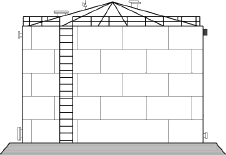
The first four tank types are cylindrical in shape with the axis oriented perpendicular to the sub grade. These tanks are almost exclusively above ground. Horizontal tanks can be used above and below ground. Pressure tanks often are horizontally oriented and spherically shaped to maintain structural integrity at high pressures. They are located above ground. Variable vapor space tanks can be cylindrical or spherical in shape.
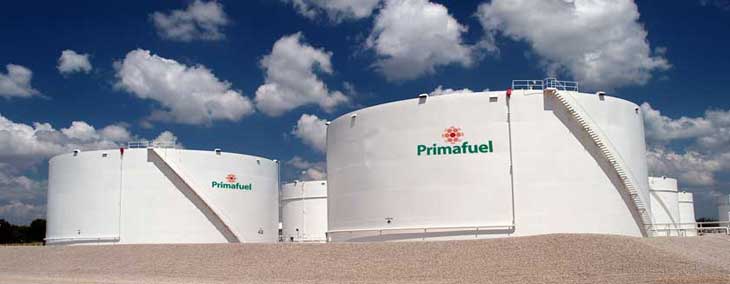 Primafuel, Tank Farm
Primafuel, Tank FarmContainment Basin
A containment basin of a product should be built around the tanks are made of brick or concrete and the lining should be impervious to liquid stored to prevent spills that can cause fire, property damage or contaminate the environment. The minimum capacity of the basin volume should be equal to the capacity of the largest tank plus 10% of the sum of the capacities of others. To prevent a spill or other emergency the walls of the containment basin must be resistant to the product and must be able to withstand considerable pressure. The drain Valve, which should be incorporated into the outer side of the containment basin, must be closed to prevent possible contamination to the environment.
Fixed-Roof Tank
Of currently used tank designs, the fixed-roof tank is the least expensive to construct and is generally considered the minimum acceptable equipment for storing liquids. A typical fixed-roof tank consists of a cylindrical steel shell with a cone- or dome-shaped roof that is permanently affixed to the tank shell. Storage tanks are usually fully welded and designed for both liquid and vapor tight, while older tanks are often have a riveted or bolted construction and are not vapor tight.
A Breather Valve (pressure-vacuum Valve), which is commonly installed on many fixed-roof tanks, allows the tank to operate at a slight internal pressure or vacuum.
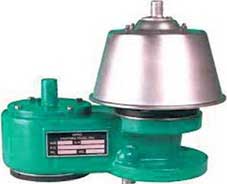
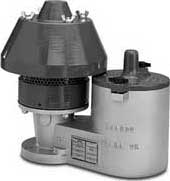
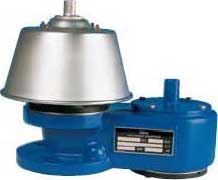
This Valve prevents the release of vapors during only very small changes in temperature, barometric pressure, or liquid level, the emissions from a fixed-roof tank can be appreciable.
Additionally, gauge hatches/sample wells, float gauges, and roof manholes provide accessibility to these tanks and also serve as potential source of volatile emissions.
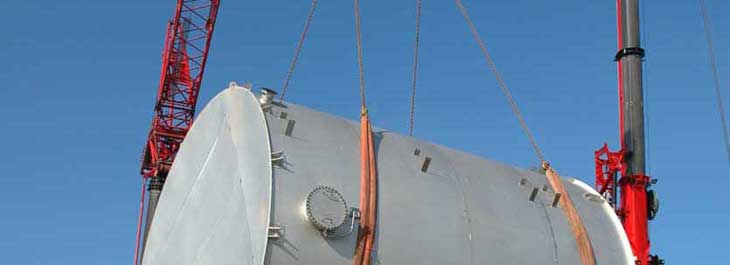 Larger image lifting and handling of a
Stainless steel Storage tank
Larger image lifting and handling of a
Stainless steel Storage tank
External Floating Roof Tank
A typical external floating roof tank consists of an open-topped cylindrical steel shell equipped with a roof that floats on the surface of the stored liquid, rising and falling with the liquid level. The floating roof is comprised of a deck, fittings, and rim seal system. Floating roof decks are constructed of welded steel plates and are of three general types.. pan, pontoon, and double deck.
Although numerous pan-type decks are currently in use, the present trend is toward pontoon and double-deck type floating roofs.
Manufacturers supply various versions of these basic types of floating decks, which are tailored to emphasize particular features, such as full liquid contact, load-carrying capacity, roof stability, or pontoon arrangement. The liquid surface is covered by the floating deck, except in the small annular space between the deck and the shell; the deck may contact the liquid or float directly above the surface on pontoons.
External floating roof tanks are equipped with a rim seal system, which is attached to the roof perimeter and contacts the tank wall. The rim seal system slides against the tank wall as the roof is raised and lowered. The floating deck is also equipped with fittings that penetrate the deck and serve operational functions. The external floating roof design is such that evaporative losses from the stored liquid are limited to losses from the rim seal system and deck fittings (standing storage loss) and any exposed liquid on the tank walls (withdrawal loss).
Internal Floating Roof Tank
That tanks has both, a permanent fixed roof and a floating roof inside. There are two basic types of internal floating roof tanks..
- tanks in which the fixed roof is supported by vertical columns within the tank
- tanks with a selfsupporting fixed roof and no internal support columns
The fixed roof is not necessarily free of openings but does span the entire open plan area of the vessel. Fixed roof tanks that have been retrofitted to employ an internal floating roof are typically of the first type, while external floating roof tanks that have been converted to an internal floating roof tank typically have a self-supporting roof.
Tanks initially constructed with both a fixed roof and an internal floating roof may be of either type. An internal floating roof tank has both a permanently affixed roof and a roof that floats inside the tank on the liquid surface (contact deck) or is supported on pontoons several inches above the liquid surface (noncontact deck). The internal floating roof rises and falls with the liquid level.
Domed External Floating Roof Tank
Domed external floating roof tanks have the heavier type of deck used in external floating roof tanks as well as a fixed roof at the top of the shell like internal floating roof tanks. Domed external floating roof tanks usually result from retrofitting an external floating roof tank with a fixed roof.
As with the internal floating roof tanks, the function of the fixed roof is not to act as a vapor barrier, but to block the wind. The type of fixed roof most commonly used is a self supporting aluminum dome roof, which is of bolted construction. Like the internal floating roof tanks, these tanks are freely vented by circulation vents at the top of the fixed roof. The deck fittings and rim seals, however, are basically identical to those on external floating roof tanks.
Horizontal Tank
Horizontal tanks are constructed for both above-ground and underground service. Horizontal tanks are usually constructed of steel, steel with a fiberglass overlay, or fiberglass-reinforced polyester. Horizontal tanks are generally small storage tanks.
Horizontal tanks are constructed such that the length of the tank is not greater than six times the diameter to ensure structural integrity. Horizontal tanks are usually equipped with pressure-vacuum vents, gauge hatches and sample wells, and manholes to provide accessibility to these tanks. In addition, underground tanks may be cathodically protected to prevent corrosion of the tank shell. Cathodic protection is accomplished by placing sacrificial anodes in the tank that are connected to an impressed current system or by using galvanic anodes in the tank. However, internal cathodic protection is no longer widely used in the petroleum industry, due to corrosion inhibitors that are now found in most refined petroleum products.
Pressure Tank
Go to Spherical and Cylindrical Pressure Vessels
Variable Vapor Space Tank
Variable vapor space tanks are equipped with expandable vapor reservoirs to accommodate vapor volume fluctuations attributable to temperature and barometric pressure changes. Although variable vapor space tanks are sometimes used independently, they are normally connected to the vapor spaces of one or more fixed roof tanks. The two most common types of variable vapor space tanks are lifter roof tanks and flexible diaphragm tanks. Lifter roof tanks have a telescoping roof that fits loosely around the outside of the main tank wall. The space between the roof and the wall is closed by either a wet seal, which is a trough filled with liquid, or a dry seal, which uses a flexible coated fabric.
Flexible diaphragm tanks use flexible membranes to provide expandable volume. They may be either separate gasholder units or integral units mounted atop fixed roof tanks. Variable vapor space tank losses occur during tank filling when vapor is displaced by liquid. Loss of vapor occurs only when the tank's vapor storage capacity is exceeded.
LNG Storage Tank
A liquefied natural gas storage tank or LNG storage tank is a specialized type of storage tank used for the storage of Liquefied Natural Gas. LNG storage tanks can be found in ground, above ground or in LNG carriers. The common characteristic of LNG Storage tanks is the ability to store LNG at the very low temperature of -162°C. LNG storage tanks have double containers, where the inner contains LNG and the outer container contains insulation materials. The most common tank type is the full containment tank. Tanks are roughly 55 m (180 ft) high and 75 m in diameter.
In LNG storage tanks if LNG vapours are not released, the pressure and temperature within the tank will continue to rise. LNG is a cryogen, and is kept in its liquid state at very low temperatures. The temperature within the tank will remain constant if the pressure is kept constant by allowing the boil off gas to escape from the tank. This is known as auto-refrigeration.
The world's largest above-ground tank (Delivered in 2000) is the 180 million liters full containment type for Osaka Gas Co., Ltd. The world's largest tank (Delivered in 2001) is the 200 million liters Membrane type for Toho Gas Co., Ltd..
Interesting articles
Related Post(s)
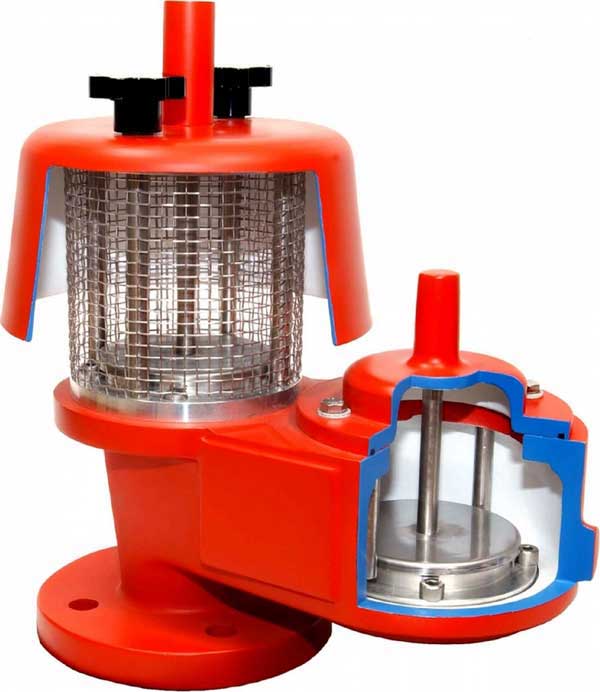
Breather Valves, also known as direct acting Pressure/Vacuum Relief Valves, are special types of Relief Valves which are specifically designed for tank protection...